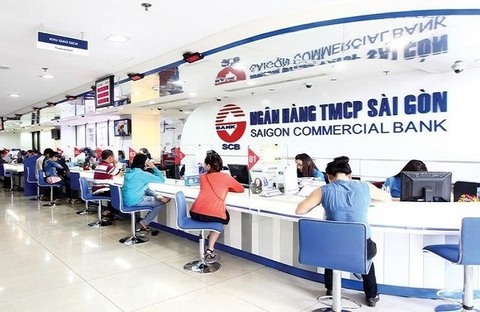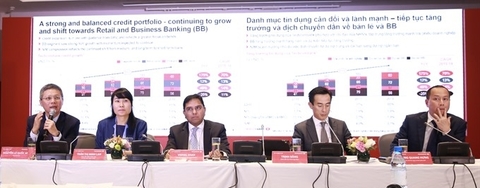FE Credit’s effort to disrupt its own business model is starting to pay off
FE Credit’s effort to disrupt its own business model is starting to pay off
Disrupting one’s own business model can be rather forward-looking for many businesses around the world and in Vietnam, yet it is exactly what FE Credit has done to both its front office and back office operations by deploying advanced technologies, to well prepare for the future.
Call of the future
While a number of its competitors have been quite comfortable launching their mobile apps in recent years to respond to the digitization era, consumer finance company FE Credit has gone the extra mile in employing cutting-edge technologies to transform its entire operations, from not only its front-end with products and services for customers, but also to the back-end where lending processes and administration work are all automated.
Such digital transformation, according to Kalidas Ghose, Vice Chairman and CEO of FE Credit, is the firm’s very responsive action to the sector that is maturing, as at the end of the day it will help the firm gain market share.
The tale of FE Credit disrupting itself, as the CEO shared in a recent interview in Ho Chi Minh City, began in early 2018 when he and his team fully deconstructed its existing business model to then rebuild it with design-thinking approach from bottom up, turning itself into a totally digitized model, in a bid to ultimately offer its customers a lending experience on par with or ahead of other developed countries.
“We completely deconstructed the existing model to be able to identify the elements which are key in building the credit history or credit profile for the customers to make a decision, and then went about searching for digital solutions that are available around the world and deciding to either use them on a pay-per-use or a variable cost basis,” noted Ghose.
“We then carefully strung them together to create a platform that is capable of delivering the best customer experience end to end, starting from the first interaction with customers on any of our channels, from the physical stores, direct sales agents or tele-sales agents to our websites or our mobile applications, and to any other channels where customers have an opportunity to contact us.”
Today, customers can experience FE Credit’s fully automated lending platforms including $NAP, which was launched last year allowing customers to apply for a consumer loan via the convenience of their smart devices, the newly launched SHIELD app that enables customers to purchase their insurance online or FE Card Mobile app that can act as virtual credit cards helping cardholders to spend at retail stores or withdraw money in areas where no ATM is available. These front-end products are seamlessly supported by the firm’s digitised back-end which includes robotic process automation (RPA) to robotise repetitive routine tasks. In addition, Big Datais also utilised to make better data drilling and therefore better and faster credit decisions for FE Credit while its Face Recognition technology will smooth the customer identification process and enhance risk management.
It is also worthwhile to note that FE Credit has integrated Vymo, a sales productivity solution that uses artificial intelligence and process automation, with its core systems, in order to improve sales productivity, drive higher conversions among sales teams, reduce loan disbursement time and improve collections.
“FE Credit customers are being on board with a sophisticated FE Credit system that requires minimal, human intervention along their [lending] journey with us. In fact, human intervention on this platform is required only when the customer is having difficulty continuing with the journey all by himself and thus requires some assistance over the phone or sometimes in rare occasions, face to face, for completing the journey,” shared Ghose.
Meanwhile, being a fairly large consumer finance company itself in the ASEAN region that processes around 25,000 loan applications on a daily basis, it would be highly disruptive for FE Credit to completely get digitized in one go, according to the CEO. The digital platform has thus been created in a laboratory environment, tested and put into practice in a phased manner, alongside the company’s traditional platform, with the complete transformation and migration to be completed within the next 12 months.
Regaining the crown
Getting ahead of the slower growth and entry of new rivals by investing in disruptive technologies seem to be a right strategy that pays due rewards for FE Credit.
Ghose said that after getting all business aspects digitized as aforementioned, together with simplified processes that now make use of e-contract and e-signature, and even digital marketing campaigns that are capable of offering customized products for existing customers or approaching customers for feedback, FE Credit has been able to reach out to “almost triple” the number of customers that it used to be able to reach via traditional physical channels like direct sales or tele sales.
On the customer end, what they will get out of FE Credit’s automated lending products and services at the end of the day is a frictionless customer experience, with faster turnaround time on personal loans, saved travel cost to the physical branches and possibly cheaper loans thanks to the lower operation costs that the company is able to save through its automated processes.
“Almost 10-15 per cent of those customers who have received customized information is actually clicking through to avail them or download our application (to make an application) on our website. This leads to approximately 1 per cent of the customers who are expressing interest to eventually take a loan disbursal. Having said that we see dramatic growth in these rates over months and we expect this to reach almost 4 to 5 percent by the end of 2019,” said Ghose.
With $NAP pilot campaign that ran from August to November 2018, in particular, FE Credit observed its loan applications and loan volume to significantly rise. On average, both application and loan volume on $NAP increased by 280 per cent a month. By the end of November 2018, the number of loan applications reached almost 150,000 with the current volume adding up to about 2,000 applications a day.
For its automated lending products and platform, the company was also named among the Best FinTech Solutions at the Singapore FinTech Festival 2018.
What’s more, the ASEAN Financial Innovation Network (AFIN), an initiative of the International Finance Corporation (IFC), also found FE Credit’s platform to be a ready-to-use, highly suitable demand-side use case, replicable across markets by partner financial institutions to complement their supply-side platform, according to Ghose.
Metasearch engine for financial products GoBear, for instance, has partnered with FE Credit in a white label partnership to exploit the latter’s automated lending platform – a move which allows the former to streamline its user journey and provide millions of local residents, easier access to loans.
Reaching further
Transforming its business model would not simply help FE Credit bolster its sales and revenue but prepare it for reaching out to provinces that are remote or segments that have not been tapped in.
According to Duong Nguyen, leader of Financial Service Organizations and IT Advisory Services at EY Vietnam, appropriate investment in technologies, especially those that help improve procedures, can help minimize or eliminate human errors, data loss while enhancing the efficiency of the lending system. At the same time, technologies can also serve as a platform for consumer finance companies to reach out to rural and remote areas to tap into the unbanked population and facilitate growth in the future.
Investment expenditure in digitization at FE Credit, according to its CEO, has been “reasonably small”, sitting at around 0.1 per cent of its revenue and 0.3 per cent of its profits last year. To keep the tech costs down, the company has spent time and effort designing and making the technologies available on a collaborative basis. “As a result of that we have actually been able to conduct or execute this digital transformation on a fairly economical basis.”
“The technology that we have deployed is capable of reaching out to every Vietnamese in every corner of Vietnam and therefore, from an accessibility point of view, we do intend to use this technology to reach out to a wider segment of customers and every single individual in the country,” noted Ghose.
Its credit card business, in particular, as Ghose added, is gearing up to be the growth engine of FE Credit for the next five years, for which the firm is targeting a credit card portfolio of 100,000 new cards a month with a long-term vision to be the largest card issuer in Vietnam.




















